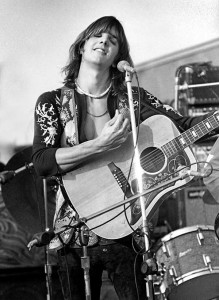 Gram’s early life was full of all the sordid ingredients that make for a classic southern gothic melodrama. Born into a filthy rich family on November 5, 1946, Ingram Cecil Connor III would lose both parents while still a teen. When Gram was 12 his alcoholic father committed suicide at the family home in Waycross, Georgia. Soon after, his mother – heiress to a Florida citrus empire – married a philanderer named Robert Parsons, who adopted Gram and his younger sister Avis. On the day Gram graduated from high school his alcoholic mother died from cirrhosis of the liver. Bob Parsons wound up marrying the household babysitter and putting young Avis in a mental institution. Gram ended up with a large trust fund that would sustain him financially for the rest of his life. He headed to Harvard, dropped out after one semester, and soon hooked up with musicians who helped crystallize his musical ambitions.
Gram’s early life was full of all the sordid ingredients that make for a classic southern gothic melodrama. Born into a filthy rich family on November 5, 1946, Ingram Cecil Connor III would lose both parents while still a teen. When Gram was 12 his alcoholic father committed suicide at the family home in Waycross, Georgia. Soon after, his mother – heiress to a Florida citrus empire – married a philanderer named Robert Parsons, who adopted Gram and his younger sister Avis. On the day Gram graduated from high school his alcoholic mother died from cirrhosis of the liver. Bob Parsons wound up marrying the household babysitter and putting young Avis in a mental institution. Gram ended up with a large trust fund that would sustain him financially for the rest of his life. He headed to Harvard, dropped out after one semester, and soon hooked up with musicians who helped crystallize his musical ambitions.
This early history is crucial, because it sheds light on how and why Gram turned out the way he did – and how he ended up writing some of the most heartbreaking songs in history. But I’ll stop here with the biographical details. There is plenty of juicy Gram lore on the Internet. All of his major personal and professional highs and lows are well documented: his hasty flight from the Byrds on the eve of a tour of apartheid South Africa; his high-output days with Chris Hillman in the early Flying Burrito Brothers; his exchange of musical knowledge, pharmaceuticals and heroin cures with brother-figure Keith Richards; his often erratic drug- and alcohol-fueled performances; his brilliant collaborations with Emmylou; his sad death from morphine and booze in Room 8 of the low-rent Joshua Tree Inn just as his solo career was taking off.
And then there’s the grandaddy of all Gram legends: the kidnapping and DIY cremation of his body in Joshua Tree National Park by his inebriated, ex-con road manager Phil Kaufman – a tale so twisted it became the basis for the moronic movie Grand Theft Parsons. This stunt, coupled with the poor-little-rich-boy saga of his early years and the high-lonesome style of his life and music, have elevated Gram Parsons to mythic status.
Like so many others who died young from misadventure, Gram has been analyzed, scrutinized and lionized by countless music historians. He’s described by all who knew him as winsome, magnetic, well-mannered, passionate, generous, visionary, even “cuddly” (yes, fellow Burrito Chris Hillman said that). One of my favorite quotes is from the superb music writer Stanley Booth, who said, “Gram was in his way a pure soul, pure and driven as the driven snow. When I met him, he looked like a green-eyed Palomino pony.”
Yet, he’s described by many of the same people as irresponsible, flighty, self-centered, spoiled, attention-hungry, musically careless, even fatalistic – destined to follow the path of his self-destructive parents. Manuel Cuevas, the Nudie’s Rodeo Costumes tailor who created some of the world’s most spectacular stage wear, speculates that Gram was predicting his manner of death when he asked him to embroider flames, poppies, multi-colored pills, marijuana leaves, a crucifix and nude women onto the famous suit he was so often photographed wearing.
In the end, what’s most important is Gram Parsons’ contributions to the world of music. One of things that most impresses me was his unflinching devotion to turning the world on to the beauty and honesty of the country sound and its natural role in what he referred to as Cosmic American Music. Tales of Gram jumping onto his motorcycle to race off and buy George Jones and Merle Haggard records to play for his country-illiterate friends are legendary.
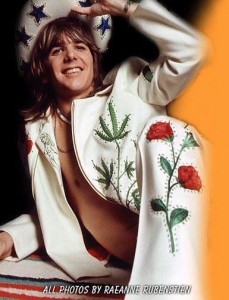 Promoting and performing country music the way he did during the height of the psychedelic, protest-era 1960s was a gutsy thing to do. His efforts offended many country purists and turned off just as many rock fans. Singing onstage in hardcore cowboy clubs wearing flamboyant, sometimes effeminate, country-western clothing took a lot of confidence (and he had it in spades). Many argue that Gram didn’t invent country rock (a genre term he hated, by the way). Others were injecting twang into modern music years before he came along. But it was this groovy, gorgeous, long-haired Harvard dropout who made country COOL. By the mid-1970s there would be a glut of soulless country rock acts. The music became mainstream, boring, and just plain commercial.
Promoting and performing country music the way he did during the height of the psychedelic, protest-era 1960s was a gutsy thing to do. His efforts offended many country purists and turned off just as many rock fans. Singing onstage in hardcore cowboy clubs wearing flamboyant, sometimes effeminate, country-western clothing took a lot of confidence (and he had it in spades). Many argue that Gram didn’t invent country rock (a genre term he hated, by the way). Others were injecting twang into modern music years before he came along. But it was this groovy, gorgeous, long-haired Harvard dropout who made country COOL. By the mid-1970s there would be a glut of soulless country rock acts. The music became mainstream, boring, and just plain commercial.
If you’re a Gram devotee, you dig what I’m saying. If you’re new to all this, go to the Internet and sample his songs. Watch some of the few available videos of his performances on YouTube. Check out his early work with the International Submarine Band, the Byrds and the Flying Burrito Brothers. Pay close attention to two of his masterpieces: “Hickory Wind” and “Hot Burrito #1.” And don’t overlook his final solo albums – “GP” and “Grievous Angel” – which feature his brilliant harmonies with the ethereal Emmylou Harris, who today is Gram’s biggest champion.
Some of these sounds will make you swing and some will make you sad. But that’s okay. Who doesn’t love a deliciously melancholy tears-in-your-beer heartache song? When I hear Gram, with his alcohol-marred, high-lonesome voice harmonizing with Emmylou on the gorgeous “A Song For You,” I can literally sense his demise. This is an audio snapshot of an artist stripped bare for all the world to see. Rest in peace, Gram Parsons. You saw your devil…and you saw your deep blue sea.
Here’s Gram and Emmylou, singing “Return of the Grievous Angel.” The great James Burton, who played with Elvis from 1969 to 1977, provided guitar on this track. “Pick it for me, James!”
And here’s the gorgeous “Hickory Wind,” which Gram wrote and performed during his short time as a member of The Byrds. When the band played the Grand Ole Opry in March 1968, Gram shocked the audience by playing this song instead of the one he was slated to perform, Merle Haggard’s “Life in Prison.” The Opry and its fans felt that Gram violated the venue’s policy of performing only pure country music.
Click here to help induct Gram in to the Country Music Hall of Fame.
Click here to learn about Hickory Wind Ranch Recovery Center, founded by Gram’s daughter, Polly Parsons.
Photo of Gram in the cowboy “Nudie Suit” is by Raeanne Rubenstein.
© Dana Spiardi, Sept 19, 2013
]]>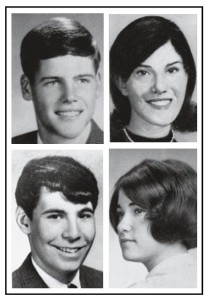 I’m referring, of course, to the Kent State University killings of May 4, 1970. Here’s the story, which we all (should) know: Students at the university were protesting America’s escalating involvement in the Vietnam War. National Guard troops, called in to control the crowds, opened fire and killed four unarmed activists. The Guardsmen claimed the students were becoming unruly and aggressive when told to disperse, and said they fired on the crowd in self defense: between 61 and 67 shots in a 13 second period. Eight Guardsmen were indicted, but in 1974 a federal judge dismissed the case against them. The victims are shown in this photo, clockwise from top left: William Schroeder, Allison Krause, Sandra Lee Scheuer, and Jeffrey Miller. Nine others were wounded.
I’m referring, of course, to the Kent State University killings of May 4, 1970. Here’s the story, which we all (should) know: Students at the university were protesting America’s escalating involvement in the Vietnam War. National Guard troops, called in to control the crowds, opened fire and killed four unarmed activists. The Guardsmen claimed the students were becoming unruly and aggressive when told to disperse, and said they fired on the crowd in self defense: between 61 and 67 shots in a 13 second period. Eight Guardsmen were indicted, but in 1974 a federal judge dismissed the case against them. The victims are shown in this photo, clockwise from top left: William Schroeder, Allison Krause, Sandra Lee Scheuer, and Jeffrey Miller. Nine others were wounded.
Gerald Casale, Mark Lewis and Mike Mothersbaugh were studying art at the college at the time of the tragedy. In the late ’60s they had become fascinated with the idea that society was regressing rather than evolving – de-evolving, so to speak. War, assassinations, civil unrest — it all fed into the mix. They began developing an interest in satirical art that reflected America’s increasing dysfunction and conformity. But what began as parody soon became deadly serious after the campus massacre on May 4. When the three friends formed a post-punk/art-rock band a few years later, they named it Devo, a shortened form of devolution.
 “All I can tell you is that it completely and utterly changed my life,” Gerald Casale told Brian L. Knight of The Vermont Review. “I was a white hippie boy and then I saw exit wounds from M1 rifles out of the backs of two people I knew. Two of the four people who were killed, Jeffrey Miller and Allison Krause, were my friends. We were all running our asses off from these motherf**kers. It was total utter bullshit. Live ammunition and gasmasks – none of us knew, none of us could have imagined. They shot into a crowd that was running. I stopped being a hippie and I started to develop the idea of devolution. I got real, real pissed off.”
“All I can tell you is that it completely and utterly changed my life,” Gerald Casale told Brian L. Knight of The Vermont Review. “I was a white hippie boy and then I saw exit wounds from M1 rifles out of the backs of two people I knew. Two of the four people who were killed, Jeffrey Miller and Allison Krause, were my friends. We were all running our asses off from these motherf**kers. It was total utter bullshit. Live ammunition and gasmasks – none of us knew, none of us could have imagined. They shot into a crowd that was running. I stopped being a hippie and I started to develop the idea of devolution. I got real, real pissed off.”
Although Devo never recorded a song specifically about the massacre, Casale once told Hustler magazine, “I don’t think I would have started Devo without that change in me.”
The most famous song to emerge from the tragedy was Crosby, Stills, Nash and Young’s “Ohio,” written by Neil Young and released one month after the killings. It peaked at number 14 on the Billboard charts. Through the years, artists have recorded at least 30 lesser-known songs about the slaughter. Here are a few.
Steve Miller’s “Jackson-Kent Blues” appeared on his 1970 album “Number 5.” This song addressed both the Kent State incident and a tragedy on May 15, 1970, in which police opened fire on Vietnam War protestors at Jackson State University, killing two and injuring five. (The words of the song are hard to decipher. Click here to see the lyrics. )
The Beach Boys recorded “Student Demonstration Time” for their 1971 album “Surf’s Up.” It’s based on the song “Riot In Cell Block Nine,” written by Jerry Leiber and Mike Stoller. Beach Boy Mike Love wrote new lyrics to the original melody.
Genesis recreated the Kent State events from the perspective of the National Guard in their 1970 song “The Knife.” Voices of the students chant “We are only wanting freedom,” as a male voice calls out, “Things are getting out of control here today,” followed by “Okay men, fire over their heads!” Sounds of gunshots, screaming and crying are interwoven into the song.
Joe Walsh, who briefly attended Kent State, wrote 1972’s “Turn to Stone” in response to the shootings. He also mentions the event in the 1992 song “Decades.”
A very young Bruce Springsteen wrote the unreleased “Where was Jesus in Ohio” in 1970 as a response to the killings. Here’s a rare recording of the song:
Jon Anderson of Yes said that some of the lyrics of “Long Distance Runaround” from band’s 1971 album “Fragile” were inspired by the Kent State murders, particularly the line “hot color melting the anger to stone.”
Dave Brubeck wrote his 1971 cantata “Truth Is Fallen” in direct response to the tragedies at Kent State University and Jackson State University.
And, of course, here’s the most famous song of all:
For the record, Chrissie Hynde of The Pretenders was also a Kent State student at the time of the shootings; she knew slain student Jeffrey Miller. Like so many others, she dropped out of school after the killings.
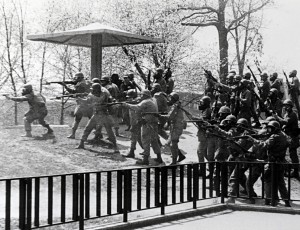 In many respects, Kent State marked the end of the peace-and-love Woodstock era. Said Gerald Casale to Mark Frauenfelder of Boing Boing in 2010, “Until then I was a hippie. I thought that the world is essentially good. If people were evil, there was justice… and that the law mattered. All of those silly naïve things. I saw the depths of the horrors and lies and the evil. The paper that evening, the Akron Beacon Journal, said that students were running around armed and that officers had been hurt. So deputy sheriffs went out and deputized citizens. They drove around with shotguns and there was martial law for ten days. 7 PM curfew. It was open season on the students. We lived in fear. Helicopters surrounding the city with hourly rotating runs out to the West Side and back downtown. All first amendment rights are suspended at the instant the governor gives the order. All of the class-action suits by the parents of the slain students were all dismissed out of court, because once the governor announced martial law, they had no right to assemble.”
In many respects, Kent State marked the end of the peace-and-love Woodstock era. Said Gerald Casale to Mark Frauenfelder of Boing Boing in 2010, “Until then I was a hippie. I thought that the world is essentially good. If people were evil, there was justice… and that the law mattered. All of those silly naïve things. I saw the depths of the horrors and lies and the evil. The paper that evening, the Akron Beacon Journal, said that students were running around armed and that officers had been hurt. So deputy sheriffs went out and deputized citizens. They drove around with shotguns and there was martial law for ten days. 7 PM curfew. It was open season on the students. We lived in fear. Helicopters surrounding the city with hourly rotating runs out to the West Side and back downtown. All first amendment rights are suspended at the instant the governor gives the order. All of the class-action suits by the parents of the slain students were all dismissed out of court, because once the governor announced martial law, they had no right to assemble.”
Tin soldiers. Four dead in O-hi-O.
© Dana Spiardi, May 4, 2014
]]>
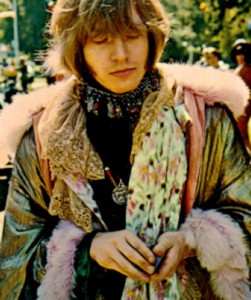 I reckon that Brian Jones was the dandiest heterosexual of the 20th century. And one of the randiest, too, having fathered at least five children with five different women by the time he was 23. But there was also real talent behind that foppish Casanova facade. Brian was one of Britain’s earliest practitioners of Delta blues. A natural musician, he was arguably the most versatile member of the band he formed and christened The Rollin Stones in 1962. And while he didn’t write, sing lead, or play solo on a single song during his career, his prowess as a multi-instrumentalist was unmatched in the rock world. He not only played a mean slide guitar, he was also proficient with harmonica, keyboards, recorder, clarinet, oboe, flute, saxophone, trumpet, trombone, sitar, tamboura, dulcimer, koto, harp, autoharp, mellotron, marimba, xylophone, glockenspiel, clavinet, banjo, accordion, harpsichord and many forms of percussion. The signature sounds you hear in “Paint it Black,” “Under My Thumb,” “Ruby Tuesday,” and “Little Red Rooster” are the work of Brian.
I reckon that Brian Jones was the dandiest heterosexual of the 20th century. And one of the randiest, too, having fathered at least five children with five different women by the time he was 23. But there was also real talent behind that foppish Casanova facade. Brian was one of Britain’s earliest practitioners of Delta blues. A natural musician, he was arguably the most versatile member of the band he formed and christened The Rollin Stones in 1962. And while he didn’t write, sing lead, or play solo on a single song during his career, his prowess as a multi-instrumentalist was unmatched in the rock world. He not only played a mean slide guitar, he was also proficient with harmonica, keyboards, recorder, clarinet, oboe, flute, saxophone, trumpet, trombone, sitar, tamboura, dulcimer, koto, harp, autoharp, mellotron, marimba, xylophone, glockenspiel, clavinet, banjo, accordion, harpsichord and many forms of percussion. The signature sounds you hear in “Paint it Black,” “Under My Thumb,” “Ruby Tuesday,” and “Little Red Rooster” are the work of Brian.
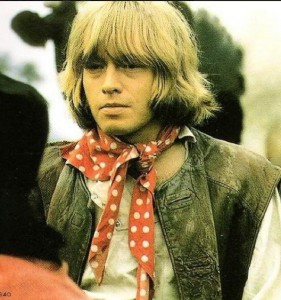 Today would have been his 73rd birthday had he not succumbed at age 27 to a drug-related drowning in his swimming pool on July 3, 1969, just weeks after his bandmates fired him for erratic, unprofessional behavior. The British coroner’s report deemed it “death by misadventure,” but many suspected foul play on the part of Frank Thorogood, a contractor who had been supervising the renovation of Brian’s Cotchford Farm estate. Thorogood, on his deathbed, supposedly confessed to murdering Jones in the pool. It’s still a mystery. Even conspiracy-mad medical examiner Cyril Wecht couldn’t confirm a bona fide murder after analyzing the autopsy report and remaining evidence.
Today would have been his 73rd birthday had he not succumbed at age 27 to a drug-related drowning in his swimming pool on July 3, 1969, just weeks after his bandmates fired him for erratic, unprofessional behavior. The British coroner’s report deemed it “death by misadventure,” but many suspected foul play on the part of Frank Thorogood, a contractor who had been supervising the renovation of Brian’s Cotchford Farm estate. Thorogood, on his deathbed, supposedly confessed to murdering Jones in the pool. It’s still a mystery. Even conspiracy-mad medical examiner Cyril Wecht couldn’t confirm a bona fide murder after analyzing the autopsy report and remaining evidence.
 Keith Richards has long doubted the deathbed confession story, figuring that Brian, unlike himself, just couldn’t cut the chemical mustard. But he sardonically suggests that the fussy Brian might have driven someone to want to murder him. “…I can imagine the scenario of Brian being so obnoxious to Thorogood and the building crew he had working on Brian’s house that they were just pissing with him,” said Keith in his book, Life. “He pissed off the builders, whining son of a bitch.” Oh, Keith!
Keith Richards has long doubted the deathbed confession story, figuring that Brian, unlike himself, just couldn’t cut the chemical mustard. But he sardonically suggests that the fussy Brian might have driven someone to want to murder him. “…I can imagine the scenario of Brian being so obnoxious to Thorogood and the building crew he had working on Brian’s house that they were just pissing with him,” said Keith in his book, Life. “He pissed off the builders, whining son of a bitch.” Oh, Keith!
With the passing of Brian, the rock world not only lost one of its pioneering (albeit, undisciplined) blues-rock talents, the fashion world lost one its most daring and original style setters. Thanks to Stones bass player Bill Wyman, who took meticulous notes during his 31 years with the band, we have a record of Brian’s buying habits. In his book, Stone Alone, Wyman describes the nature of Brian’s shopgasms:
 “Our sharpest dresser, he spent a small fortune at boutiques. Collecting clothes might have been his kind of therapy, as he shopped more frequently during times of stress: the day after his court case was adjourned he went to Chelsea Antique Market for a spree typical in its list of exotic purchases: a mandarin coat, a pink fringed coat, pink velvet cape, a flannel-and-lace jacket, embroidered and velvet jackets, two velvet scarves, four pairs of trousers, two kimonos and two scarves, two strings of bells, a blouse and a pink beaded belt. In New York, too, Brian had indulged himself in expeditions to the ladies jewelry departments of such stores as Saks Fifth Avenue and Bergdorf Goodman. A New York journalist friend commented: ‘If he gave nothing else to the world, Brian was the first heterosexual male to start wearing costume jewelry from Saks Fifth Avenue.'”
“Our sharpest dresser, he spent a small fortune at boutiques. Collecting clothes might have been his kind of therapy, as he shopped more frequently during times of stress: the day after his court case was adjourned he went to Chelsea Antique Market for a spree typical in its list of exotic purchases: a mandarin coat, a pink fringed coat, pink velvet cape, a flannel-and-lace jacket, embroidered and velvet jackets, two velvet scarves, four pairs of trousers, two kimonos and two scarves, two strings of bells, a blouse and a pink beaded belt. In New York, too, Brian had indulged himself in expeditions to the ladies jewelry departments of such stores as Saks Fifth Avenue and Bergdorf Goodman. A New York journalist friend commented: ‘If he gave nothing else to the world, Brian was the first heterosexual male to start wearing costume jewelry from Saks Fifth Avenue.'”
 Well, he might have been a peacock, masking myriad neuroses with velvet and chintz, but Mr. Jones gave a lot more to the world than man-bracelets and puka shell necklaces. Although there are those among you who will disagree, there would have been no Rolling Stones without Brian Jones. Sure, Mick and Keith would have gone on to be huge rock stars; Charlie and Bill to be highly respected rhythm men. But Brian was the one with the vision for a pure blues band – back when Mick was still contemplating a career as a pin-striped businessman.
Well, he might have been a peacock, masking myriad neuroses with velvet and chintz, but Mr. Jones gave a lot more to the world than man-bracelets and puka shell necklaces. Although there are those among you who will disagree, there would have been no Rolling Stones without Brian Jones. Sure, Mick and Keith would have gone on to be huge rock stars; Charlie and Bill to be highly respected rhythm men. But Brian was the one with the vision for a pure blues band – back when Mick was still contemplating a career as a pin-striped businessman.
And while most of us Stone-heads consider the band’s post-Brian LPs to be among the best and most enduring rock albums ever made, there’s no denying the significance of his early contributions. As Wyman once said, “He formed the band. He chose the members. He named the band. He chose the music we played. He got us gigs…very influential, very important, and then slowly lost it — highly intelligent — and just kind of wasted it and blew it all away.”
Another once-beautiful dead flower. Rest in peace and paisley, Brian Jones!
Here is a montage of photos showing Brian Jones in all his glory. “Who could hang a name on you?”
© Dana Spiardi, Feb 28, 2014
]]>
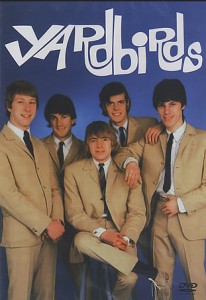 In 1963 Relf, along with bassist/producer Paul Samwell-Smith, drummer Jim McCarty, and rhythm guitarist Chris Dreja, formed a band rooted in American blues and R&B music. They chose their name with a nod to beat writer Jack Kerouac, who referred to railroad hobos as yardbirds in his novel On The Road. Lead guitarists came and went, starting with Clapton, then Beck, and finally Page. Relf has long been overshadowed by these giants. And it’s a pity, because he was one of the first great British blues-rock singers.
In 1963 Relf, along with bassist/producer Paul Samwell-Smith, drummer Jim McCarty, and rhythm guitarist Chris Dreja, formed a band rooted in American blues and R&B music. They chose their name with a nod to beat writer Jack Kerouac, who referred to railroad hobos as yardbirds in his novel On The Road. Lead guitarists came and went, starting with Clapton, then Beck, and finally Page. Relf has long been overshadowed by these giants. And it’s a pity, because he was one of the first great British blues-rock singers.
When The Yardbirds disbanded in 1968, Relf went on to form three other music ventures: a short-lived acoustic duo called Together, and later the bands Renaissance and Armageddon. In 1976 the singer was on the verge of forming a group called Illusion, a re-working of his original Renaissance lineup. On May 14 of that year he was in his basement rehearsing material for the band, when he electrocuted himself while playing a guitar that was not properly grounded. His 8-year-old son found him, still holding the plugged-in guitar. Keith Relf was 33. His sad death gives new meaning to the term electric blues.
Here’s hipster Keith, singing “For Your Love” with the Jeff Beck-era Yardbirds (1965)
© Dana Spiardi, March 22, 2014
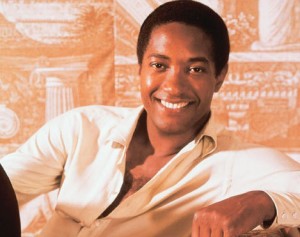 Bertha Franklin, who managed the Hacienda Motel in Los Angeles, told police that Cooke entered her motel office in a rage, searching for a woman – Elisa Boyer – that he had taken to his room earlier in the evening. Boyer later claimed she was afraid he was going to rape her, and fled the motel. At that point, an inebriated Cooke barged into the motel office in only his shoes and a sport coat. Franklin said he became violent, so she grabbed her gun and shot him – at least 3 times.
Bertha Franklin, who managed the Hacienda Motel in Los Angeles, told police that Cooke entered her motel office in a rage, searching for a woman – Elisa Boyer – that he had taken to his room earlier in the evening. Boyer later claimed she was afraid he was going to rape her, and fled the motel. At that point, an inebriated Cooke barged into the motel office in only his shoes and a sport coat. Franklin said he became violent, so she grabbed her gun and shot him – at least 3 times.
Cooke’s friends and family never accepted the story. They claimed his murder was part of a conspiracy or police cover-up, due to inconsistencies in the various testimonies. Boyer was later arrested on prostitution charges, and many suspect she accompanied Cooke to the motel with plans to rob him. His clothes and a large sum of money were never recovered. Whatever the sad circumstances, the world lost one of its most gifted artists that day. He was only 33.
Here’s a video of Sam’s hauntingly beautiful composition “A Change is Gonna Come.” Released after his death, it’s one of the earliest protest songs of the civil rights movement. Please watch it as a reminder of what life was like in America just a few generations ago. Change has come, but it becomes more apparent every day that we’ve still got a LONG way to go.
© Dana Spiardi, Dec 11, 2013
]]>